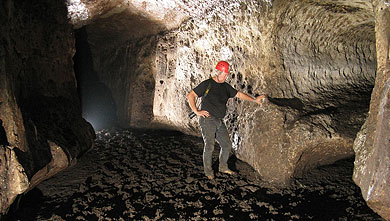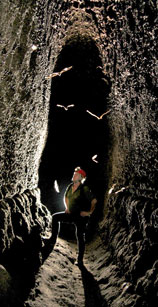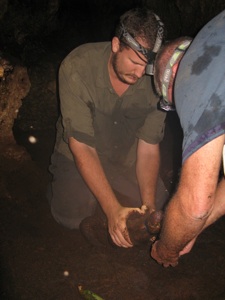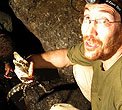
The Crocodiles Caves of Gabon


« I'm walking slowly in a straight gallery. Thousands of bats are flying all around me and the noise they make is a bit scary. The fluttering of the wings produces a strong air flow and I must protect my eyes with my arm. I'm often hit in the head by some unlucky animals. The odour of the bat guano is nauseating and I retch...
Suddenly, 4 meters from me, two glowing eyes. Two big glowing eyes in the dark. I am watching the creature. It's watching me
Ok, turn around, I think it's time to call it a day ! »
Olivier Testa
Inside the caves...
Gabon is a biodiversity hotspot. The tropical forest that covers 85% of the
country still hides many secrets.
Scarcely known caves are hidden under the thick cover of the impenetrable rainforest, and large karst areas still need to be explored.
In August 2010, a Scientific and speleological expedition lead by Archaeologist Richard Oslisly and a pluridisciplinary scientific team started research in this coastal area of Africa, near the Fernan Vaz laguna.
They discover that the caves are inhabited by cave-dwelling crocodiles, a first in central africa.
Objectives
The main objective of the expedition was to find a way through the lush vegetation and the rainforest to access the caves of Abanda which were reported to us. We planned to explore and survey these caves, and to carry out preliminary research on potential archeaological remains.
The caves

During the two expeditions, 15 cave mouths were visited, leading to the exploration of two small cave systems (Mugumbi and Dinguembou) surveyed by speleologist Olivier Testa. The caves are fossil karstic conduits developping in cretaceous limestone along two main directions, says geologist David Sebag. The orientation are consistent with the major fault system that structures Gabon.
Though the rock is undoubtedly limestone with many fossil shells of marine life, no speleothems can be found in the galeries.
The shape of the galleries strongly suggest that the genesis of the caves s linked with the quaternary climatic changes and the variations of sea level.
Cave Biology - crocodiles

In Abanda caves can be found orange cave-dwelling crocodiles. Several individuals are trapped in the caves,
the only entrance to the cave being a 7 m deep pit. of the genus Osteolaemus.
In 2010, we managed to catch a 170 cm long male indivual, and take it out. Its skin is orange-colored, a never observed before feature. Complementary studies will tell
us if it is a physiological degeneration linked to a long period in the darkness, or a consequence of a particular unbalanced diet.
Crocodiles living in caves are rare, and have been seen only in very few places in the world. It is the first time they are observed in Central Africa.
Since then, we caught other crocodiles. Read next
Cave Biologie - Bats

This caves hosts several bat colonies of different species (Rousettus aegyptiacus, Hipposideros aff. ruber, et Hipposideros aff. Gigas).
More than 50.000 bats live in Dinguembou Cave, and they fly at dusk every day to feed on fruits.
Bats of Gabon have also been identified as the natural reservoir of Ebola virus by Eric Leroy from IRD (CIRMF). The bat guano that covers the floor contains myriads of invertebrates, and a sampling of this soil fauna
have been made.
The biodiversity of the caves of Gabon has never been studied before. These recently discovered corcodiles and bats are only a few example of the
abundant underground fauna. Insects, snakes crabs, shrimps, depigmented fish, have been observed in the caves of Gabon.
Read next: The cave crocodiles
Share this page with your friends




